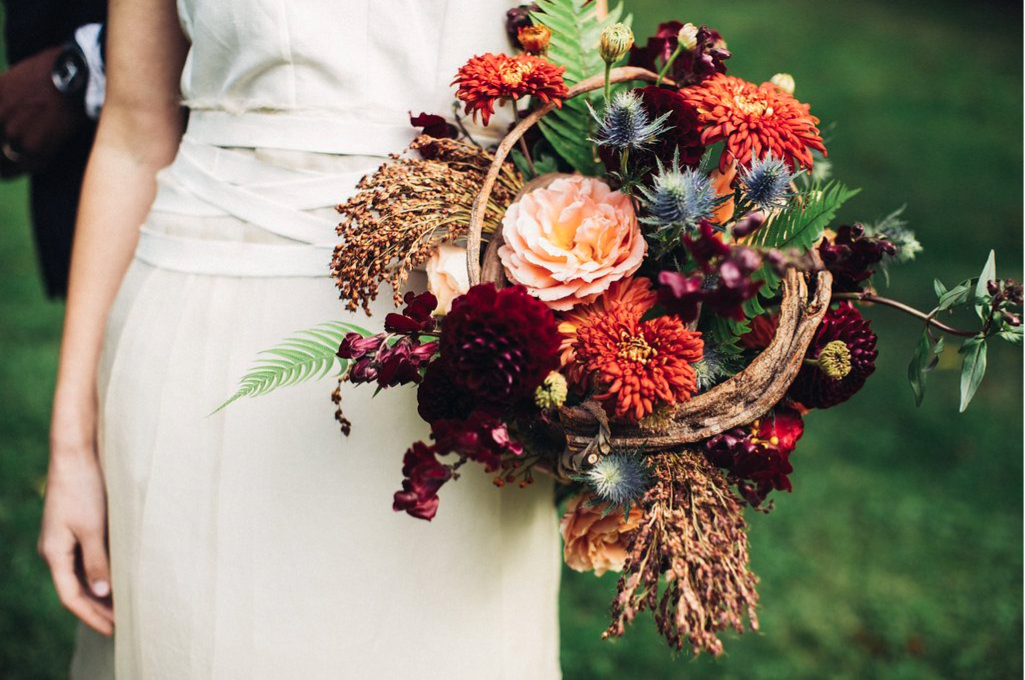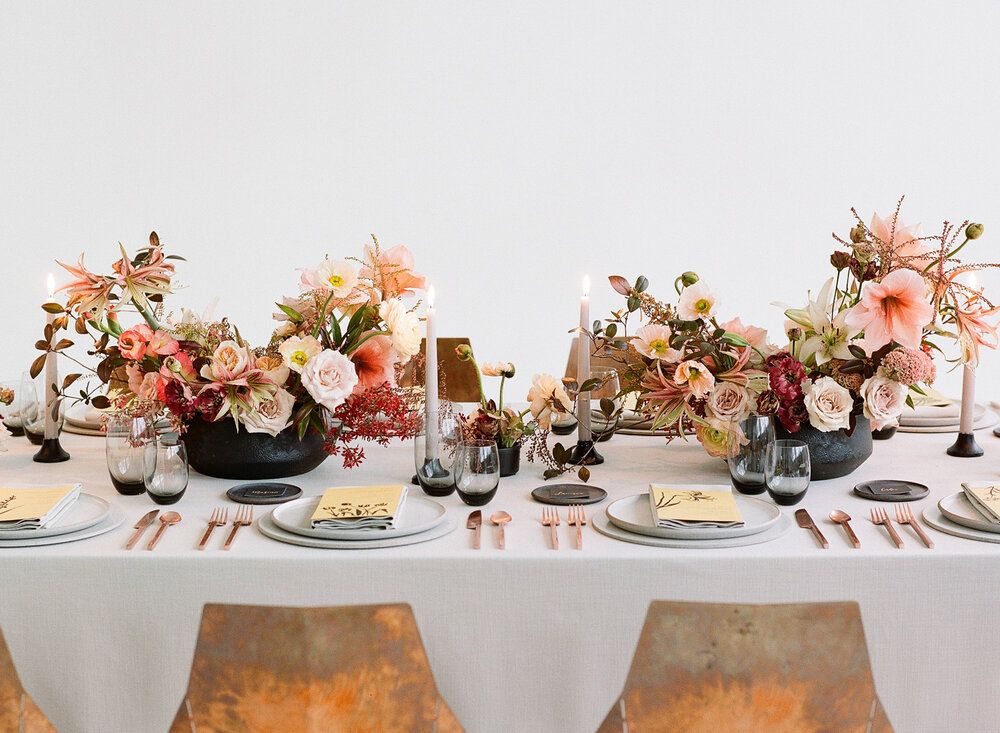Photo credit: Image courtesy of Photosynthesis Floral Design
Environmentally conscious consumers are increasingly seeking eco-friendly products. According to a 2021 Nielsen study, 67% of consumers in the U.S. are willing to pay more for sustainable products.
Sourcing local flowers is at the nexus of environmental concerns: imported flowers have the second highest carbon footprint among agricultural products!
We spoke to several designers about how they meet client requests while sourcing American-grown flowers from small and mid-size farms. As a designer, you have an opportunity to highlight local as a unique selling point and differentiator for your business.
If you’re starting to think about shifting to local product but aren’t sure where to begin, we can help! This is the first of a series of articles on how to start the transition to local by building flexibility into your client’s vision, setting expectations, and creating beautiful, sustainable designs that reflect the season.
Related: Check out our Local Staples: A Substitution Guide for Popular Flowers post for 5 of the most commonly imported flowers and some local alternatives.
Setting Expectations & Embracing Seasonality
When imagining their designs, clients may present you with a couple of loose concepts or an extensive Pinterest board. It is up to you, as the designer, to translate the mood and desired aesthetic to life, but that does not mean you need to follow inspirational photos to a T.
If the starring blooms in a client’s photos are not in season at the time of their event, offer locally sourced alternatives and provide images for those alternatives. They will be able to see that you can achieve a similar look with the flowers you are suggesting. Lead with shape, form, and color palette.
Designers who incorporate local offer one big piece of advice for this communication process: Refrain from promising specific flowers for events.
By not promising specific flowers and varieties, you gain creative freedom and flexibility to use what’s in-season vs. ordering imports (and hoping your delivery does not contain unusable stems.)
Buying locally means leaning into the tension a little bit-- being honest, earlier on, that I may not know what exact variety will be available by which exact date. I actually can’t guarantee a specific flower for a specific date. But what I can do is communicate the color palette that works best for their style for this time of year, which varieties I plan on using, whether the stems will be whimsical, romantic, or wild, etc.
Rachel Fletcher, Carbon & Co.
 Photo credit: Image by Sullivan and Sullivan photography, flowers by Tobey Nelson Events
Photo credit: Image by Sullivan and Sullivan photography, flowers by Tobey Nelson Events
Educating Clients on the Benefits of Local
Part of the relationship-building process is about helping educate your clients on the benefits and value of supporting local: the quality and freshness are unmatched; locally grown product has a substantially smaller carbon footprint and they are supporting local businesses! Help your customers understand how they are contributing to a larger cause.
Local flowers are not a compromise or a sacrifice. They are unique, nuanced, and can add depth to your designs that can be hard (or next to impossible) to achieve with imported items. Much of what local farmers grow (e.g., dahlias, lisianthus, zinnias), cannot be sourced globally because they do not ship well in cold temperatures and have a shorter postharvest vase life.
Your designs will be unique and special because they represent the time and place in which the flowers are grown. You can more clearly represent each client’s vision with the abundance available to you locally.
I talk about freshness & quality and educate them on the real cost of imports and the benefits of local: carbon footprint, pesticide use, investing in local economy vs large corporate farms. In 2021 and moving forward we also talk about the likelihood of getting the things we want, and that choosing locally grown things are more reliable. I also describe how locally farmed blooms often have more character, fragrance, and grace than imports.
Tobey Nelson, Tobey Nelson Events & Design
It’s nice to be able to tell my clients that I can get them things others that go through traditional wholesaler routes can’t.
Sarah Saunders, Sarah Saunders Studio
You grow when you use what’s growing. It challenges you and you figure out how to make more unique designs.
Rhea Calpeno, Photosynthesis Floral Design
 Photo credit: Rebecca Yale; Flowers Sarah Saunchers Studio
Photo credit: Rebecca Yale; Flowers Sarah Saunchers Studio
One way to get clients on board and set expectations early on is to clarify your values when it comes to sourcing flowers for their event. Below is a sample of some of the copy Rhea Calpeno of Photosynthesis Floral Design includes in her initial services package document that highlights their commitment to sustainability:
We believe in doing our part to help lighten our ecological footprint. As a floral studio, our commitment to sustainability comes into play in every phase of our work: from planning, sourcing, design, and installation to break-down after an event. Flowers are grown all over the world, with a large percentage coming from other countries. To lower our carbon footprint, we strive to source flowers that are in season and locally grown from farms that follow sustainable and fair-trade practices. We invite you to join us in our effort to support our local farmers by making their flowers a priority.
Using local is a great selling point for me. I write it in proposals, in phone calls. It’s not getting shipped in, therefore the flowers have a smaller carbon footprint. My clients are supporting my small business and I get to support other small businesses. I’m willing to fly in to supplement depending on the season but the bulk of what I buy is sourced locally.
Sarah Saunders, Sarah Saunders Studio
Pro-tip: If you source from a local flower market/cooperative or directly from a local farmer, inquire about receiving a sample harvest calendar. This can be a valuable resource when learning what is in season throughout the year.
Clients are seeking ways to make their event personalized and want vendors that offer sustainable options. By embracing locally grown flowers, you can reduce your business’ carbon footprint, help your clients achieve their vision, and accomplish an aesthetic that is different from any other design. And you can do all of this by working with your fellow flower friends: farmers!
Read part 2 of this series! Part 2: Designers Guide for Building Flexibility into Proposals
Categories

About the Author
Rooted Farmers
The Rooted Farmers Team is happy to bring you content that we hope provides value. The topics covered range from farming and running a hub, to sales, marketing, and all things related to building your business, to the unique challenges faced by growers. Our philosophy in sharing this content is that we are always in a position to learn; embracing this mentality will only help us to grow, both within our businesses and personally. If there is a topic that you feel would be of value to the Rooted Farmers community, we encourage you to share your ideas with us by sending an email to: reachout@rootedfarmers.com
